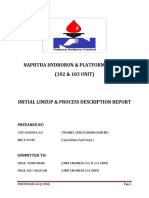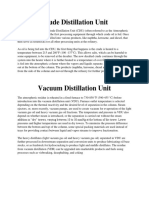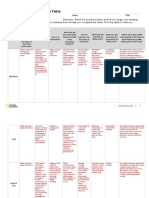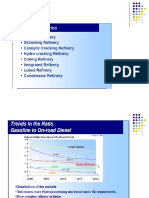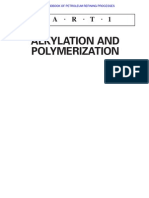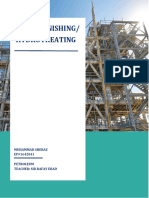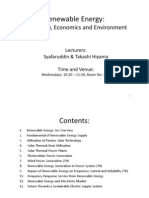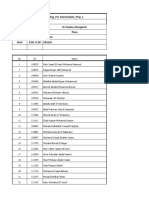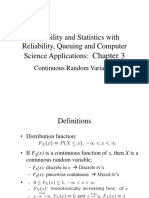HFU and HGU
HFU and HGU
Uploaded by
umairz01Copyright:
Available Formats
HFU and HGU
HFU and HGU
Uploaded by
umairz01Original Description:
Copyright
Available Formats
Share this document
Did you find this document useful?
Is this content inappropriate?
Copyright:
Available Formats
HFU and HGU
HFU and HGU
Uploaded by
umairz01Copyright:
Available Formats
SECTION 9: HFU and HGU
Hydro Finishing Unit
Hydrotreating of dewaxed lube oil stocks is needed to remove chemically active compounds that
affect the color and color stability of lube oils. The Lube Oil Fraction Reduce from MEK Process
still contain trace amount of compounds which are not suitable for long life lubricating oils.
These undesirable compounds combined with O2 at elevated temperatures encounter in engines
and machinery to produce sludge. These compounds can not be successfully removed via
extraction process, therefore these compounds are hydrogenated in a process called hydro
finishing. Most hydrotreating operations use cobaltmolybdate catalysts and are operated at a
severity set by the color improvement needed. Organic nitrogen compounds seriously affect the
color and color stability of oils, and their removal is a major requirement of the operation. The
process flow is the same as that for a typical hydro treating unit. Representative operating
conditions are:
Ahsan Jalal
NRL # 60275
Usually finished oil yields are approximately 98% of dewaxed oil feed.
The hydro finisher is a hydrogenation process in which hydrogen gas chemically combines with
Sulphur to form Hydrogen sulphide present in the feed. Hydrogenation process also saturates the
olefins of the feed stock which improve the colure of product. The reaction takes place under
high pressure and temperature in presence of the catalyst.
The following reactions are taking place in the reactor,
Desulphurization:
The hydrogen gas combines with the sulphur compound, present in the feed stock and
hydrogen sulphide is produced. e.g.
C20H41-S-H +H2--------> C20H42 + H2S
Olefin Saturation:
The Olefin groups of hydro carbons are present in the feed stock. The olefins are
unsaturated hydrocarbons. During the process the hydrogen is added to unsaturated
hydrocarbons to saturate it. E.g.
R-CH2=CH2 + H2----------> CH3-CH3
Denitrification:
Nitrogen is also present in the feed stock; it combines with Hydrogen to form Ammonia.
Oxygen removal:
Oxygen is also present in the feed it combines with hydrogen to form water.
Page |1
SECTION 9: HFU and HGU
Process Parameters:
The hydro finishing chemical reaction take place at transfer line (T/L) temperature of 515 oF to
525 oF. In the rector temperature is 473 oF to 492 oF. The heat of the reaction is provided by a
furnace, located before the reactor. The process reaction takes place under high temperature and
pressure. The system pressure is 500 to 535 Psi, this pressures is control by PRC-2.The system
pressure make up by compressors K2 A/B and storage hydrogen bottle (V3, V4 & V5). Normally
the feed to reactor have 250-300 SCF of hydrogen gas for every barrel of feed.
Process description:
The unit is designed to hydro tread the feed WFO (Wax free oil) pumped to the unit from the
storage tank.The hydrogen coming from HGU (hydrogen generation unit). Hydrogen gas mix
with WFO after FRC-1 (at feed pump 16 P-1).The WFO and hydrogen gas is pre heated in shell
side of exchanger 16 E-1 (tube side E-1 is outlet of 16 P-2 after dryer) then again heated in the
shell side of exchanger of 16 E-2 (Tube side is reactor effluent).It is further heated in a furnace to
gain the final reaction temperature of 515 oF to 525 oF. Now the stream is introduce in the reactor
where the Chemical reaction takes place. The reactor top temperature is 473 oF to 492 oF and bed
temperature is 470 oF to 493 oF. Stream comes out from the bottom of the reactor at
451oF.Stream cooled in tube side of 16 E-2 and introduced into separator 16 V-1. The reactor top
temperature of the separator, Hydrogen gas = hydrogen Sulfide remain on top the oil layer. Gas
leaves from the top of the separator to Compressor 16 K-1 A/B followed by air cooler E-3, where
gas recycles. The Oil leaves, from the bottom of the separator to Stripper 16 C-1. The Hydrogen
WFO collected in the separator, still contains light Hydrocarbons, H2 and H2S, which do not
separate from stream. The heat necessary to separate light Hydrocarbons from the stream at the
rate of 1040 Lbs/h at temperature of 930 to 940o F. The undesirable products are comes out from
the stream due to high bottom temperature and lower pressure of the stripper and travel up the
stripper column in the shape of vapors. The condensation takes place as the vapors pass through
water cooler and the collected into hot well V-8. The non condensable vapors are flare in the
atmosphere. Then pump 16 P-2, pumped to Air cooler 16 E-4 A/BC/D. The Hydro finished
products stored in storage tanks.
Ahsan Jalal
NRL # 60275
Hydrogen Generation Unit (HGU)
The hydrogen used in the process of hydro finishing is generated in HGU. The units involve in
HGU are as follows
Carbon Drum
Reformer
CO converter
Absorber (for the absorption of CO2 gas)
Methanator
Page |2
SECTION 9: HFU and HGU
Process description:
Natural gas is first passed through the carbon drum where the sweetening of natural gas is done
by the removal of sulphur contents present in the natural gas. Steam is used as reforming agent in
the reformer. The steam is entered at about 700 oC. The catalyst used in reformer is nickel oxide
along with MgCl2 and Al2CO3. The gaseous stream coming out of reformer has temperature of
about 920 oC .The composition of this stream is as follows
H2=74%, CO2=4% & CO=22%.
After that it is introduced into CO converter where almost all of CO is converted in to CO2. The
next unit is CO2 absorber where 30% solution of MEA (Mono ethanol amine) is used to remove
CO2 from stream. After passing this stream through CO2 absorption column, it still contains
small amount in methanator and hydrogen free from CO2 is send into hydrogen bottle.
Ahsan Jalal
NRL # 60275
Page |3
You might also like
- 2013 8 2 Noll Concord BlueDocument12 pages2013 8 2 Noll Concord BlueljmuhamedNo ratings yet
- Hydrogen Gas Production by Partial OxidaDocument69 pagesHydrogen Gas Production by Partial OxidaChinwuba Samuel EbukaNo ratings yet
- Cargo Gear Deck CraneDocument2 pagesCargo Gear Deck Cranesmoj09100% (3)
- Project BenzenDocument12 pagesProject BenzenahmedNo ratings yet
- Petroleum Refining GlossaryDocument7 pagesPetroleum Refining GlossaryPradeep MunnaNo ratings yet
- Roadmap For Adaptationon Low Sulphur FuelDocument65 pagesRoadmap For Adaptationon Low Sulphur FuelHHHNo ratings yet
- Energy Optimization of Crude Oil Distillation Using Different Designs of Pre-Flash Drums PDFDocument7 pagesEnergy Optimization of Crude Oil Distillation Using Different Designs of Pre-Flash Drums PDFGabriela Urdaneta100% (1)
- Egeberg 2010 - Hydrotreating in The Production ofDocument13 pagesEgeberg 2010 - Hydrotreating in The Production ofNadia RizanedewiNo ratings yet
- HDCV 5000 ManualDocument30 pagesHDCV 5000 ManualaleksandrNo ratings yet
- EH-EM Service Instructions Coin-Logi-Intelli Control 344739, 11-6Document46 pagesEH-EM Service Instructions Coin-Logi-Intelli Control 344739, 11-6Hugo RoMo67% (3)
- 102 & 103 Hydrotreater ReportDocument31 pages102 & 103 Hydrotreater ReportMuhammadNo ratings yet
- Reforming Catalyst Regenration: M.Saleem Chohan Syed Kashif HassanDocument17 pagesReforming Catalyst Regenration: M.Saleem Chohan Syed Kashif HassanSaleem ChohanNo ratings yet
- Sulfur PDFDocument21 pagesSulfur PDFjjtpiNo ratings yet
- Proposal 2Document7 pagesProposal 2Engr. Asif malikNo ratings yet
- Crude Distillation UnitDocument1 pageCrude Distillation Unitnew styleNo ratings yet
- Training Report of IoclDocument71 pagesTraining Report of IoclAnupam SrivastavNo ratings yet
- Murphy Oil USA, Inc Meraux Refinery SO2 Emission Basis ObjectionsDocument43 pagesMurphy Oil USA, Inc Meraux Refinery SO2 Emission Basis ObjectionsHot TopicsNo ratings yet
- Crude Oil DesulphurizationDocument11 pagesCrude Oil DesulphurizationmartinNo ratings yet
- STRATCO Contactor Economic Analysis1Document13 pagesSTRATCO Contactor Economic Analysis1Shahzaib GujjarNo ratings yet
- Aalborg Micro Alfa LavalDocument1 pageAalborg Micro Alfa LavalPanzerNo ratings yet
- Energy Perfomance Assessment For Equipmenet and UtilityDocument24 pagesEnergy Perfomance Assessment For Equipmenet and Utilityhasan shoaibNo ratings yet
- Unit 2 1Document4 pagesUnit 2 1Sadagopan RajaNo ratings yet
- Atmospheric Distillation of Crude OilDocument2 pagesAtmospheric Distillation of Crude OilAnonymous FGzDAs0SoNo ratings yet
- Nickel Alloys For Sulfuric Acid ProductionDocument5 pagesNickel Alloys For Sulfuric Acid ProductionHeanjiaAlloysNo ratings yet
- Fossil Fuels Classfication Table ANSWERKEYDocument2 pagesFossil Fuels Classfication Table ANSWERKEYIrganesh MadagundiNo ratings yet
- Sulfur Recovery 2Document12 pagesSulfur Recovery 2iffatNo ratings yet
- Feasibility Report On Production of LPG From Natural GasDocument18 pagesFeasibility Report On Production of LPG From Natural GasDanish KhanNo ratings yet
- C CC CC: CCCCCCCCCCCCCCCCDocument27 pagesC CC CC: CCCCCCCCCCCCCCCCMuhammadTanzeeLUsmanNo ratings yet
- Unit 2 Refining Process - 3Document28 pagesUnit 2 Refining Process - 3prathamesh singhNo ratings yet
- ERC Refinery ProjectDocument16 pagesERC Refinery ProjectTarek Fawzy100% (1)
- Lecture 1Document22 pagesLecture 1Amit Narayan RaiNo ratings yet
- Catalytic Conversion Processes - Cont'd: AlkylationDocument13 pagesCatalytic Conversion Processes - Cont'd: AlkylationHina IbrahimNo ratings yet
- Advanced Catalytic Olefins ACO First Commercial Demonstration Unit Begins OperationsDocument12 pagesAdvanced Catalytic Olefins ACO First Commercial Demonstration Unit Begins OperationsmakhadermfNo ratings yet
- Nptel Lecture Notes 2Document21 pagesNptel Lecture Notes 2balusappsNo ratings yet
- What Is DesulfurizationDocument20 pagesWhat Is DesulfurizationYash NandurkarNo ratings yet
- Natural Gas Dehydration Using TEG Simulation FileDocument7 pagesNatural Gas Dehydration Using TEG Simulation FileChakravarthy BharathNo ratings yet
- Desalter Operating CondirtionsDocument5 pagesDesalter Operating CondirtionsmacielNo ratings yet
- AspenHYSYS YourveryfirstHYSYSSimulationDocument60 pagesAspenHYSYS YourveryfirstHYSYSSimulationkiranchemenggNo ratings yet
- HPCL IT DHDS Block OverviewDocument37 pagesHPCL IT DHDS Block OverviewSrija Mummidi100% (1)
- PRPC - All CH - by Kenil JaganiDocument102 pagesPRPC - All CH - by Kenil JaganiVarun pandeyNo ratings yet
- Virial EquationDocument5 pagesVirial EquationQwertyNo ratings yet
- Processes 09 00207 v2Document19 pagesProcesses 09 00207 v2Hamza AliNo ratings yet
- Department of Chemical EngineeringDocument24 pagesDepartment of Chemical EngineeringMNIT Literary SocietyNo ratings yet
- Fantastic Magazine of KnowledgeDocument44 pagesFantastic Magazine of KnowledgeRajan BalkiNo ratings yet
- Install Vru S651torage TanksDocument9 pagesInstall Vru S651torage TanksNacho.pNo ratings yet
- Catalytic Reforming - 2Document31 pagesCatalytic Reforming - 2adityarajchikkalaNo ratings yet
- DHDSDocument36 pagesDHDSravichandraNo ratings yet
- Ar001Document10 pagesAr001Gary ClarkNo ratings yet
- BlendingDocument1 pageBlendingsaikat janNo ratings yet
- Refinery Training Courses by PertecnicaDocument7 pagesRefinery Training Courses by PertecnicapertecstudentNo ratings yet
- Fluid Catalytic Craking Unit (Fccu)Document6 pagesFluid Catalytic Craking Unit (Fccu)Nitin VarshneyNo ratings yet
- INDMAX Technology: Production of Light Olefins/ LPG & High Octane Gasoline From Petroleum ResidueDocument3 pagesINDMAX Technology: Production of Light Olefins/ LPG & High Octane Gasoline From Petroleum ResidueMinhquang NgoNo ratings yet
- Steam CrackingDocument4 pagesSteam CrackingJoseph BirungNo ratings yet
- SulfolaneAppendices A EDocument158 pagesSulfolaneAppendices A Erkhandelwal9604No ratings yet
- Coal GasificationDocument16 pagesCoal GasificationSheheryar MirzaNo ratings yet
- Direct Dimethyl Ether Synthesis: Takashi Ogawa, Norio Inoue, Tutomu Shikada, Yotaro OhnoDocument9 pagesDirect Dimethyl Ether Synthesis: Takashi Ogawa, Norio Inoue, Tutomu Shikada, Yotaro OhnoM Alim Ur RahmanNo ratings yet
- Cooler 1 - 6Document31 pagesCooler 1 - 6Agung Prasetyo NugrohoNo ratings yet
- A Clean Energy FutureDocument6 pagesA Clean Energy FutureHendry DrajatNo ratings yet
- HDTB SectorDocument7 pagesHDTB SectorPartha AichNo ratings yet
- HD Ro FinishingDocument6 pagesHD Ro FinishingMuhammad sherazNo ratings yet
- Ammonia ProductionDocument28 pagesAmmonia ProductionMuhammad Ali HashmiNo ratings yet
- UpdatedChapter3 4Document48 pagesUpdatedChapter3 4mystorewelcome1No ratings yet
- MAN Echopulser Eng 01Document42 pagesMAN Echopulser Eng 01Lê Nguyên TríNo ratings yet
- Aromatic Ammonia Spirit: Rhodalyn C. Lana Janimah M. LiwalugDocument19 pagesAromatic Ammonia Spirit: Rhodalyn C. Lana Janimah M. LiwalugRye M. Birung100% (1)
- Lecture 1Document28 pagesLecture 1Kamara KumaraNo ratings yet
- Theory of Planned BehaviorDocument10 pagesTheory of Planned BehaviorMonica MateoNo ratings yet
- 2022 EF ClimateChange ProvisionalProgramme 16sep 0Document3 pages2022 EF ClimateChange ProvisionalProgramme 16sep 0Beate HeisterNo ratings yet
- ITALYDocument34 pagesITALYmbogadhiNo ratings yet
- Physical Sciences P1 Feb-March 2016 EngDocument17 pagesPhysical Sciences P1 Feb-March 2016 Engthembekilethusi9No ratings yet
- MS Sas 4Document5 pagesMS Sas 4rereNo ratings yet
- FM Global - Fire Suppression Physics For Sprinkler ProtectionDocument14 pagesFM Global - Fire Suppression Physics For Sprinkler ProtectionChidi Henry100% (1)
- Gazette International 25Document156 pagesGazette International 25Nándor Ferencz Nagy100% (1)
- SOP Emp Health Hygiene Rev4 10Document3 pagesSOP Emp Health Hygiene Rev4 10Hanna SeftianaNo ratings yet
- English 6 Q3 Week 8Document5 pagesEnglish 6 Q3 Week 8LORIAN COMETANo ratings yet
- English Groups 09 10 TitlesDocument322 pagesEnglish Groups 09 10 Titlesyomna25No ratings yet
- Curso Python para PrincipiantesDocument6 pagesCurso Python para PrincipiantesYanquiel Mansfarroll GonzalezNo ratings yet
- Proposed General Arrangement Plan For Bay 9: Storage Area Storage Area Storage AreaDocument1 pageProposed General Arrangement Plan For Bay 9: Storage Area Storage Area Storage Areasherwin suarezNo ratings yet
- The Design For Wastewater Treatment Plant WWTP With GPS X Modelling PDFDocument34 pagesThe Design For Wastewater Treatment Plant WWTP With GPS X Modelling PDFTariq Al DheiratNo ratings yet
- RK315DT ManualDocument88 pagesRK315DT Manualjean riveraNo ratings yet
- Science Action - BOOK 2Document46 pagesScience Action - BOOK 2saisssms911650% (2)
- Solutions Assignment 7Document7 pagesSolutions Assignment 7Sammei DanniyelNo ratings yet
- Pulsed Eddy CurrentDocument22 pagesPulsed Eddy CurrentTHIRU.SNo ratings yet
- Volvo February 2014 New Monthly Releases PV776-K-D16F Engine TOC PDFDocument5 pagesVolvo February 2014 New Monthly Releases PV776-K-D16F Engine TOC PDFCesar Bayes RamosNo ratings yet
- Kewo AD800 Freuquency InverterDocument12 pagesKewo AD800 Freuquency InverterVahe YeghyanNo ratings yet
- Simulation & Analysis of Distribution Static Compensator (D-STATCOM)Document4 pagesSimulation & Analysis of Distribution Static Compensator (D-STATCOM)Teja BhogadiNo ratings yet
- Gantt Chart 17Document31 pagesGantt Chart 17ousmanebelem776No ratings yet
- Mathematics 9758/01: Anglo-Chinese Junior College Jc2 Preliminary ExaminationDocument41 pagesMathematics 9758/01: Anglo-Chinese Junior College Jc2 Preliminary ExaminationVarshLokNo ratings yet
- 330 84 PBDocument91 pages330 84 PBDekaria AlamandaNo ratings yet
- Probability and Statistics With Reliability, Queuing and Computer Science ApplicationsDocument91 pagesProbability and Statistics With Reliability, Queuing and Computer Science ApplicationsNatar AdriNo ratings yet










